Our Everyday Cinema - omnibus
2025
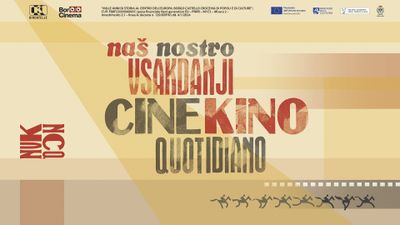 For decades, Kinoatelje has explored the film heritage of the Gorizia region, tracing memories and stories that flow across borders. From this lineage emerges a new chapter: an omnibus where the steering wheel was handed to a new generation of filmmakers. This omnibus of short films was filmed in Gorizia — in streets and by rivers where histories intertwine, a threshold city carved out of its own pulse. Guided by director Alessandro Comodin and inspired by Our Everyday Cinema by Sandro Scandolara, five auteurs — Jan Devetak, Ester Ivakič, Otto Lazić-Reuschel, Laura Samani and Francesco Sossai — dismantled the frontier into a polyphonic portrait of a town.
For decades, Kinoatelje has explored the film heritage of the Gorizia region, tracing memories and stories that flow across borders. From this lineage emerges a new chapter: an omnibus where the steering wheel was handed to a new generation of filmmakers. This omnibus of short films was filmed in Gorizia — in streets and by rivers where histories intertwine, a threshold city carved out of its own pulse. Guided by director Alessandro Comodin and inspired by Our Everyday Cinema by Sandro Scandolara, five auteurs — Jan Devetak, Ester Ivakič, Otto Lazić-Reuschel, Laura Samani and Francesco Sossai — dismantled the frontier into a polyphonic portrait of a town.
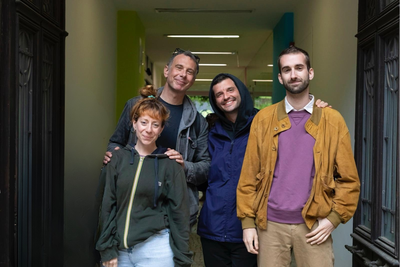
“We wanted to create a collective experience that would bring together creative voices, their passion for cinema, and their curiosity in discovering the stories of our city. These films were made in modest conditions; without genuine and profound inner motivation, they would never have seen the light of day. In the year of the European Capital of Culture GO! 2025, we wanted to mark this historic moment by creating something new – a gift that will remain as a legacy for future generations.” - Mateja Zorn, Head of Programme at Kinoatelje
The collective film Our Everyday Cinema was created as part of the BorGO Cinema project, which brings together various film associations from Gorizia and is financially supported by the PNRR Borghi initiative. The aim of the programme is to revitalise and enrich the cultural life of Gorizia’s historic city centre. Kinoatelje saw in this an opportunity to develop a film-tourism offering, creating cinematic walks that give residents and visitors a unique way to rediscover Gorizia — through the lens of cinema. The film is also part of the European Capital of Culture GO! 2025 programme.
FILMS
 LIEBESTRAUM, 12', Jan Devetak
LIEBESTRAUM, 12', Jan Devetak
Actress Nora Gregor dies at the age of forty-seven, in her final exile in Santiago de Chile, three weeks after learning of her mother’s death. It is January 20, 1949. A second later she opens her eyes – and finds herself in Gorizia in the year 2025.
Jan Devetak: "I made a film about home, family, and aging. By coincidence, these are also the words that come to mind when I think of Gorizia, the city where I come from. Into the film I also wove hope, because even though we live in dark times, the cross-border nature of our city fills me with hope. In this process I rediscovered strong roots."
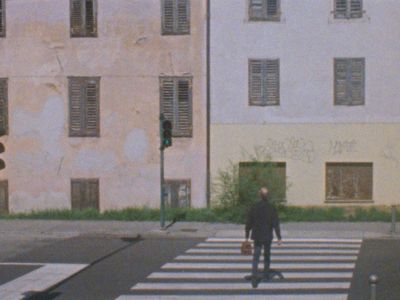 IN THE CLOUDS OF MEMORY, 8', Francesco Sossai
IN THE CLOUDS OF MEMORY, 8', Francesco Sossai
A figure appears from the future — sent from a world in which Cinema no longer exists — to retrieve a copy of a film starring Nora Gregor. Told in the first person by a Japanese director, as if it were a small psycho-geographical diary about the city of Gorizia.
Francesco Sossai: "I met him on the day of failure. I was writing a screenplay, I thought Italy would inspire me - its architecture, the way of life in the squares. I liked Gorizia, border town, between one world and another. When you come from far away though, the borders are more blurred. I came from far away. From Sendai. I wanted to write, desperately wanted to write, but all I had managed to do was get lost. Far from Japan, there was nothing to tell. The man appeared to me on a bench — I use the verb appear because that's what it was: he appeared like in an old silent movie, through a fade-out."
From here, from this account, begins the journey of a Japanese filmmaker inside Gorizia and its secret cinematic treasures: an encounter with a man from the future, a future where Cinema no longer exists, who returns to his past, our present, in search of a reel containing the close-up of Nora Gregor.
To save what can be saved from oblivion.
Rumor has it that Titian's greatest painting is the Martyrdom of St. Peter, commissioned by the parish of Zanipolo in Venice — the extraordinary culmination of the Cadore artist's art was irretrievably lost after a violent fire broke out in the parish. What would happen if we could go back in time and save the painting from its destruction? With this spirit of paradox is told this little story.
 NO ONE WILL BELIEVE US, 12', Otto Lazić-Reuschel
NO ONE WILL BELIEVE US, 12', Otto Lazić-Reuschel
Gorizia, 1930. Through the gaze of the cameraman of the Fascist Afterwork Club (OND) we see the regime’s marches and the celebration. By imagining the voice of his thoughts, we delve into his insecurities and his surrender to a silent dissent. The images remain, continuing to tell of a time that has yet to pass.
Otto Lazić-Reuschel: "After discovering the Simonelli Fund—the archival material gathered by Cristaldo Simonelli, whose surname was Simončič before the rise of fascism—I was fascinated by all those recordings made by the Fascist National Afterwork Club (OND—Opera Nazionale Dopolavoro).
This material, preserved by Kinoatelje, immediately struck me and pushed me to reflect and imagine how somebody with a cross-border identity might have come to terms with fascism. In our case, we tried to put ourselves in the shoes of the cameraman who was standing, partly out of fear and partly out of respect, behind the lens. We identified with his memories and hopes, imagining them through the eyes of someone who today knows what went on yesterday."
 NOTHING IS CERTAIN – Two strolls in Gorizia, 16', Laura Samani
NOTHING IS CERTAIN – Two strolls in Gorizia, 16', Laura Samani
Summer in Gorizia. A couple is about to leave for their holidays. Between empty streets and closed cinemas, it all feels already behind them. Only Paolino remains, drifting through the city, reminiscing about a lost love.
Laura Samani: "This project was conceived as a research: to map the vanished cinemas of Gorizia. As it often happens, we ended up finding something else."
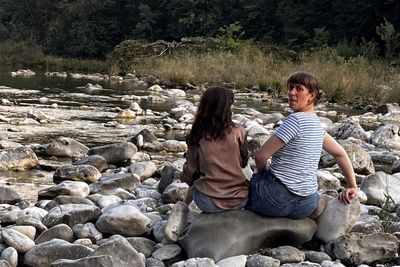 BAMBI BY THE RIVER, 6', Ester Ivakič
BAMBI BY THE RIVER, 6', Ester Ivakič
Two girls dream of watching the famous Bambi cartoon at the cinema. But when the show is sold out, they turn the riverside into their very own cinema.
Ester Ivakič: "Working with our own imagination and building ourselves a place outside a traditional one was always an interest of mine, also friendship, love and nature. It was only natural that when I stumbled across an article about the film Bambi that was always sold out, two girls came into my head and their story unfolded like this."
ALESSANDRO COMODIN
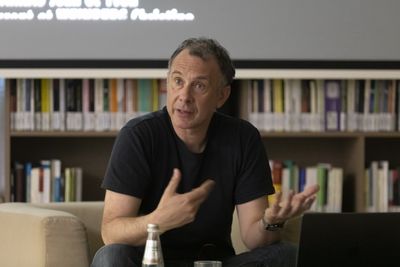 These five filmmakers created their works dedicated to the Gorizia area under the guidance of Alessandro Comodin. Born in the Friulian area, Alessandro Comodin began to establish himself in the film world in 2009, when his graduation short film, Jagdfieber, was presented at Cannes. A few years later, in 2011, his first feature film, L’estate di Giacomo, won the Pardo d’Oro at the Locarno Film Festival and numerous other awards in various international festivals. Between 2016 and 2022, he directed three films: I tempi felici verrà presto, Fiori bianchi, and Gigi la legge, for which he won the Special Jury Prize in the international competition at the Locarno Film Festival in 2022.
These five filmmakers created their works dedicated to the Gorizia area under the guidance of Alessandro Comodin. Born in the Friulian area, Alessandro Comodin began to establish himself in the film world in 2009, when his graduation short film, Jagdfieber, was presented at Cannes. A few years later, in 2011, his first feature film, L’estate di Giacomo, won the Pardo d’Oro at the Locarno Film Festival and numerous other awards in various international festivals. Between 2016 and 2022, he directed three films: I tempi felici verrà presto, Fiori bianchi, and Gigi la legge, for which he won the Special Jury Prize in the international competition at the Locarno Film Festival in 2022.
"From my perspective, this invitation was a tremendous privilege, and I tried to convey this to the invited artists right from the start. Indeed, no one would ever think of making a film in Gorizia based on Scandolara's book. So I tried to remind them that, despite its utterly strange and almost absurd nature, this project is a tremendous blessing and a gift, because of its unparalleled originality. This is a unique moment in history.
First of all, each of us received the book, which is a unique object because it's a collection of observations and memories about cinema in Gorizia. It's a peripheral vision, outside of the major cinematic movements; it's all very local, yet so central to the history of the last century. It's as if we'd opened a trunk in a private home and found these writings by Scandolara. These pages have a cryptic and mysterious quality, and we all had the same feeling of being in a sort of time capsule. These observations, seen from... I don't know, Paris or Rome, might seem entirely anecdotal, but seen from the perspective of a filmmaker, they become something truly magical.
Let's say the project really blossomed when we realized who our guests were: my colleagues. Consequently, I was a sort of accomplice, an interlocutor. I listen, I argue, and if I don't like something, I make it very clear. But I tried with each of them to be very respectful of who they are and how they understand their cinema. I also tried to set limits on my interventions because the films are, of course, the fruit of discussion, but in the end, they rightfully belong to them. So the relationship was completely horizontal."



